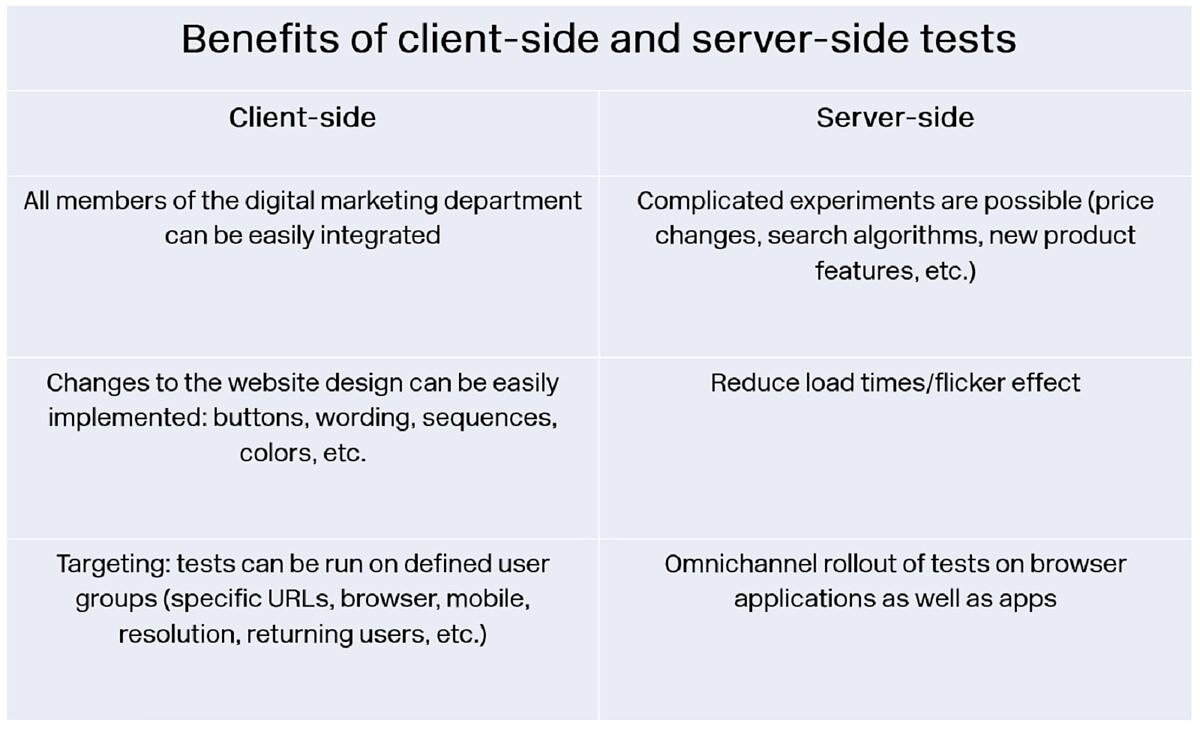Full stack testing: why the full stack approach should be a key part of your future A/B testing strategy

When it comes to implementing A/B tests, website providers generally have two options: client-side or server-side A/B tests. Which approach is most suitable usually depends on the specific business requirements, such as the company structure, internal resources, and most importantly the structure and goals of the tests to be run.
But what exactly are client-side and server-side tests? How do the two approaches differ and what benefits do they each offer? In this article, we examine the different fields of application, and also demonstrate that you no longer have to choose between the two, since the full stack approach lets you simply combine the benefits of both methods using hybrid tests!
Client-side vs. server-side
With client-side testing, the web pages are modified directly in the visitor’s browser. For this purpose, the source code of the original page is forwarded from the server to the visitor’s browser and a script (JavaScript, CSS, HTML, etc.) steers the desired changes directly in the browser (whether it is Chrome, Firefox, Safari, Opera, etc.) to display a version of the modified page. In this way, A/B tests and personalizations can be created very quickly for the purposes of placing text, changing call-to-action buttons, arranging blocks, or adding pop-ins, for example.
Client-side tests and personalizations do not require advanced technical skills and are easy for digital marketers to implement. From a website provider’s perspective, client-side A/B tests are particularly beneficial because they are extremely flexible and can be run by a large number of marketing team employees.
“Client-side tests not only enable you to monitor scroll and click KPIs, they also offer a major benefit in terms of targeting. If tests are only to be run for certain target groups (e.g. desktop vs. mobile users), the client-side approach comes with significantly more possibilities.”
But does the client-side testing approach still cut it today? Does running A/B tests at a purely front-end level measure up to the modern world’s more complex standard user, who consumes websites and services on an omnichannel basis?

Working server-side means that optimization hypotheses are created on the back-end architecture side. The changes are directly generated when the HTML pages load, meaning that all the test elements are controlled from directly within the coding environment. More in-depth tests and personalizations can therefore be realized on the architecture and running of websites.
“Wherever logic plays a large role in the back end, server-side testing is a must. Complicated tests, for example in relation to different pricing models, can’t just be run at a front-end level, since they affect connected systems, such as invoicing and bookkeeping programs. Such experiments that concern either the sales funnel or also search algorithms can offer significantly high added value, but they have to be carried out professionally on the server side.”

Full stack: leverage the benefits cross-functionally
The full stack approach makes it easy to combine the benefits of client-side and server-side A/B tests and should be integrated as part of any modern testing strategy, not just for technical reasons, but also from a data protection perspective. It gives website providers the ability to run complicated, omnichannel tests and at the same time include targeting options.
In a single interdisciplinary testing campaign, price changes, for example, can thus be tested on an omnichannel basis (back end), while aspects such as the price display design and color will depend on whether or not the visitor is a returning user (front end). On Kameleoon’s full stack platform, you can implement precisely that combination so that marketing and IT teams can work together on experiments and personalizations.
Why full stack could also be the decisive factor in your testing strategy
#1 Trend toward cross-functional teams
Due to the increasing complexity of digital marketing, there has recently been a clear trend toward cross-functional teams. Website providers are putting a great emphasis on collaboration between digital marketers, UX specialists, analysts, front-end developers, back-end developers, and hybrid developers (front end and back end). When a full stack framework is incorporated, these players are able to design A/B tests together in such a way that they can be run as quickly and effectively as possible for everyone involved. These different perspectives are essential for getting a 360-degree view of the user.
#2 360-degree tests from multiple perspectives
The increasingly popular full stack framework provides an overall picture of users when it comes to A/B tests as well. Testing campaigns can now track users beyond the client-side and server-side level, thereby allowing tests that are based on specific user groups to be run more accurately over a longer period of time. An example case:
“One of our customers recently wanted to test a website button that takes the user to the Apple Store where an iOS application relevant to the customer’s service can be downloaded. Kameleoon’s full stack platform made it possible to test the design of the button on the client side and at the same time also recognize users at the server level after they download the app by means of a unique identifier, categorize them into a certain user group, and continue the testing campaign.”
#3 Data privacy compliant and flexible at the same time
Differentiated targeting features that also work across websites often use third-party cookies. Numerous GDPR-related laws are significantly complicating the use of cookies at the browser level by stipulating precise rules about cookie duration and the design of opt-in banners. The full stack approach can be used to conduct testing at the client level and at the same time trace a user by setting a first-party cookie at the server level. With that in mind, implementing a full stack testing strategy is also very worthwhile for companies for data protection reasons.
#4 State of the art: adapting A/B tests to the latest architectural developments
For some time now, a trend has been emerging in which modern web applications are being written in Node.js or server-side JavaScript, for example. At the browser level, website providers are also increasingly working with JavaScript frameworks, such as Vue.js, AngularJS or React, in order to improve performance on a long-lasting basis. That is creating a big challenge for client-side testing, since it is normally the “events” (reloading and calling up a web page) that trigger an A/B test at the DOM (Document Object Model) level.
To achieve this performance boost, the modern JavaScript frameworks ensure that once a web page has been loaded, the client does not send any more requests to the server and only parts of the web page are reloaded. The full stack approach provides the solution here as well with its optimal adjustment to modern web applications. Accordingly, it can be predefined in the SDK (server-side) what modifications are also to be performed at the client level (banner changes, call-to-action buttons, etc.) for a particular website area.
Growing collaboration within cross-functional teams, the development of testing campaigns from multiple perspectives, data protection, and the early detection of trends in modern web applications are all important reasons why you too should equip your company with a full stack testing strategy. With its full stack platform, Kameleoon offers a professional tool and actively supports you in implementing your testing strategy.





